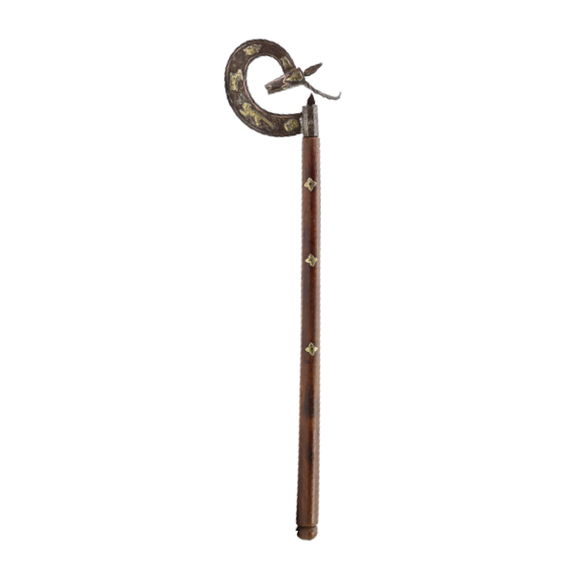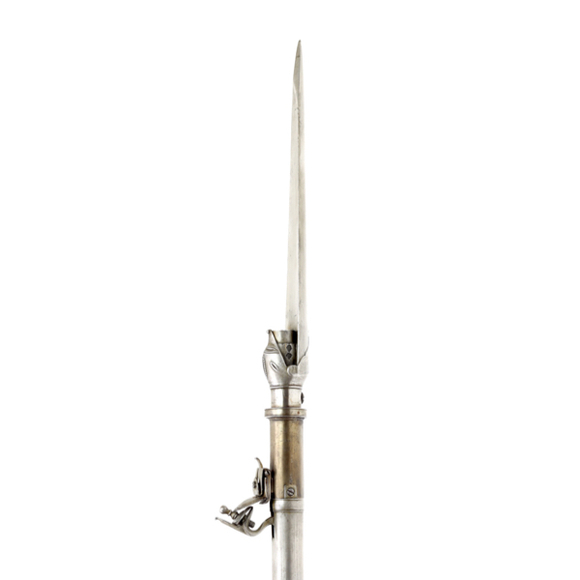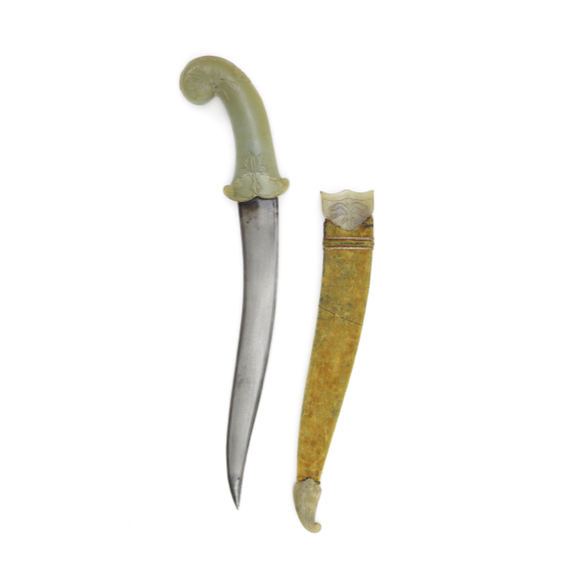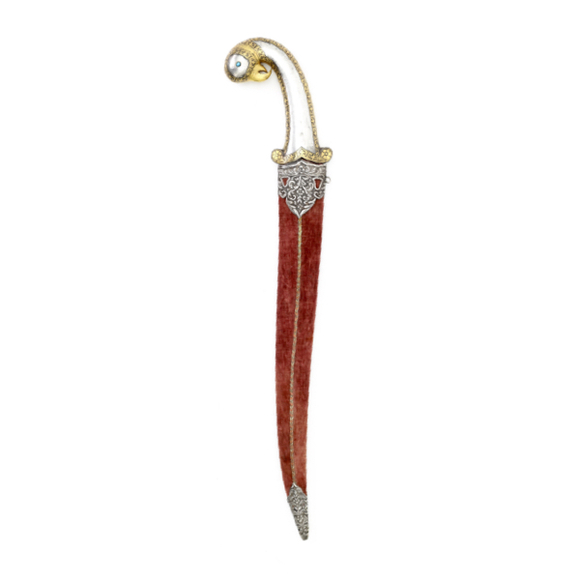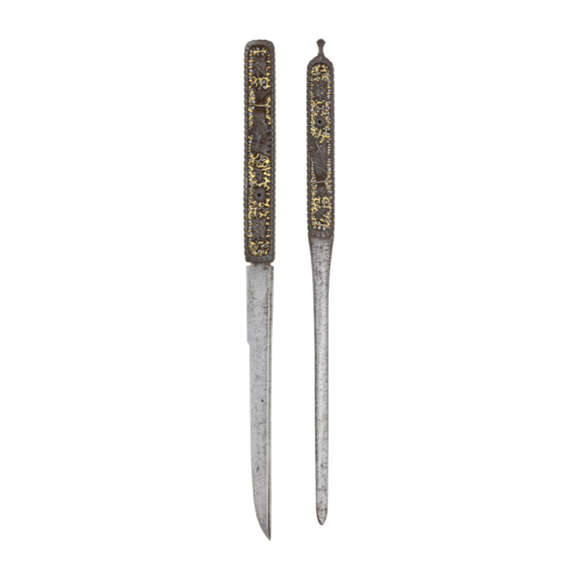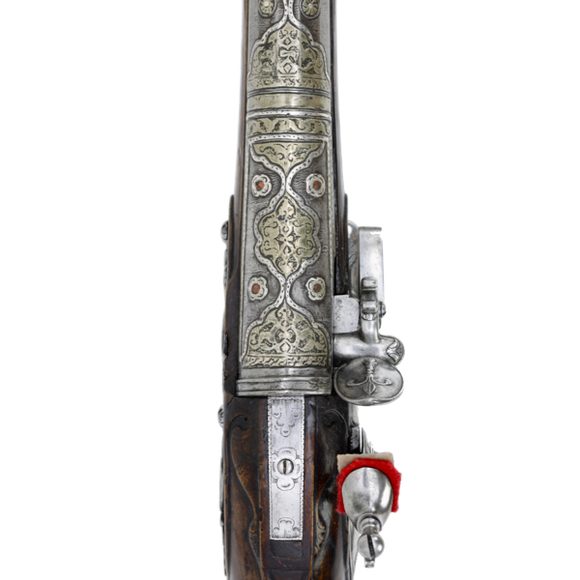An enigmatic type of axe, this one probably from tribal north India.

34.2 cm
22.5 cm
Base 8 mm
Reinforced tip 6 mm
Base 60 mm
Reinforced tip 19 mm
376 grams
2 cm into hilt
Iron, steel, gold, lacquer
Mughal dominions
North India
Circa 1575-1625
From a U.K. based collector and dealer
Introduction
Today we know all steel daggers with slender grips and wide splitting pommels as chilanum, after its mention by Egerton in 1896.1 However, the Mughal term for them as it appears in the Ain-I-Akbari of circa 1590 is kapwah.2
Kapwah of this particular form, with a pommel like a gable roof, appear already in the Akbar period version of the Bāburnāma, "History of Babur".3

Early gable-roofed kapwah in the late 16th century Bāburnāma.

Prince Nur Al Din Mohammad Salim, the future Emperor Jahangir. 1601.
From the St. Petersburg Muraqqa' Album.
Russian Academy of Sciences E-14 f.93a.

Emperor Jahangir Weighs Prince Khurram.
Page from Tuzuk-i Jahangiri. 1610-1615.
Notice a small kapwah worn by the figure on the left, and the small one on the tray near the emperor's feet.
British Museum, London 1948,1009,0.69
The world's most famous kapwah is probably the one that is thought to have belonged to 5th Mughal emperor Shah Jahan, famous builder of the Taj Mahal and father of Mughal emperor Aurangzeb. It is kept in the Wallace Collection, accession number OA1409. Its hilt is made of pure gold, decorated with almost two thousand diamonds, rubies and emeralds. It is thought to be the same dagger that Shah Jahan is depicted with in a 1616 painting in the Victoria & Albert Museum, accession number IM.14-1925. Another such dagger is in the Al Sabah collection in Kuwait.4

The Shah Jahan kapwah.
Wallace Collection, London.
The popularity of these daggers appears to have peaked during the reign of Emperor Jahangir, who personally favored them greatly. The popularity waned some years into Shah Jahan's reign, as by the 1630s, he was customarily depicted with a katar dagger instead. His successor Aurangzeb also seemed to have preferred wearing katar.
This puts the use of these daggers in the late 16th to the first three decades of the 17th century.
Notes
1. Lord Egerton of Tatton: A Description of Indian and Oriental Armour, with an Introductory Sketch of the Military History of India. London, W.H. Allen & Co. 1896. Page 102.
2. The Ain-i-Akbari (Persian: آئینِ اکبری) or "Administration of Akbar" was commissioned by Emperor Akbar himself (reigned 1556-1605) and written by court historian Abu'l Fazl (1551-1602). It is written in Persian and describes the Mughal empire as it was around 1590. The original manuscript is housed in the Hazarduari Palace, India. For a translation, see volume I by Heinrich Blochmann, 1873.
3. Bāburnāma is an illustrated manuscript with the memoirs of Bābur (1483–1530), founder of the Mughal Empire. It was translated from the original Turkic in 1589-1590. The Walters Art Museum contains 30 of its folios, and another 57 are in the State Museum of Eastern Cultures, Moscow.
4. Salam Kaoukji; Precious Indian weapons and other princely accouterments. Dar Al-Athar Al-Islamiyyah The Al-Sabah collection, Kuwait. Thames & Hudson, London, 2017. Pages 92-93.
This example
A striking early form of Indian dagger. It has a curved, double edged blade with a center rib and a gently thickening at the point. The blade is most likely a fine wootz, but I did not want to disturb its current blade finish to find out.
The hilt consists of a faceted vase-like grip section and a wide pommel in the form of a gable with on each side a stylized monster head, one holding a ring. The split base that connects to the blade terminates in what appears to be a goat's head on one side. On the other, an elephant head complete with two tusks sprouts the knucklebow, which in turn terminates in a horse's head. At the top is a turban-shaped knob.
The hilt was once decorated with lots of gold, only a little of which remains. There are also remains of black lacquer.
Comparable examples
There is a plain steel version of this dagger in the Furusiyya Art Foundation Collection. It has a wootz blade. The hilt is of slightly simpler geometry, and no efforts have been made to decorate it.1
The elephant head is a rarer feature on these daggers and something ours only shares with the lavish example in the Al-Sabah collection.2
Notes
1. See David Alexander; Arts of the Muslim Knight. Skira, Milano, 2008. Page 183.
2. Salam Kaoukji; Precious Indian weapons and other princely accouterments. Dar Al-Athar Al-Islamiyyah The Al-Sabah collection, Kuwait. Thames & Hudson, London, 2017. Pages 92-93. See photo.
Conclusion
An over 400-year-old dagger that is attributable to the Mughal court of the late 16th to the first quarter of the 17th century. It is simpler in execution from the Wallace and Al-Sabah collections, yet its closeness in geometry to those examples means it was produced in the same place and time, probably to be worn by a lesser courtier.










A what? Yes exactly. An extremely rare piece, the only example I am aware of in published collections at…
Nice and complete with opaque green hilt and scabbard mounts.
The only set of its type known to me in both private and museum collections.

